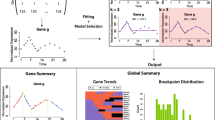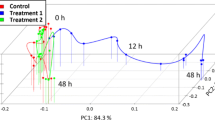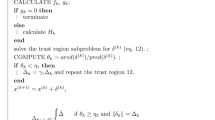Abstract
Discovering responsive or differentially expressed genes in time-course microarray studies is an important step before further interpretation is carried out. The statistical challenge in this task is due to high prevalence of situations in which the following settings are true: (1) none or insufficiently fewer repeats; (2) 0-time or starting point reference; and, (3) undefined or unknown pattern of response. One simple and effective criterion that comes for rescue is smoothness criterion which assumes that a responsive gene exhibits a smooth pattern of response whereas a non-responsive gene exhibits a non-smooth response. Smoothness of response may be gauranteed if the expression is sufficiently sampled and it can be measured in terms of first order or serial autocorrelation of gene expression time-course using Durbin-Watson (DW) test. But, the DW-test ignores variance of the response which also plays an important role in the discovery of responsive genes while variance alone is not appropriate because of nonuniform noise variance across genes. Hence, we propose a novel Data-driven Smoothness Enhanced Variance Ratio Test (dSEVRaT) which effectively combines smoothness and variance of gene expression time-course. We demonstrate that dSEVRaT does significantly better than DW-test as well as other tests on both simulated data and real data. Further, we demonstrate that dSEVRaT can address both 0-time normalized data and the other data equally well.
Preview
Unable to display preview. Download preview PDF.
Similar content being viewed by others
References
Bansal, M., Gatta, G.D., di Bernardo, D.: Inference of gene regulatory networks and compound mode of action from time course gene expression profiles. Bioinformatics 22(7), 815–822 (2006)
Benjamini, Y., Hochberg, Y.: Controlling the false discovery rate: a practical and powerful approach to multiple testing. J. Roy. Stat. Soc. B. 57, 289–300 (1995)
Karuturi, R.K.M., Vinsensius, B.V.: Friendly NeighborsMethod for Unsupervised Determination of Gene Significance in Time-courseMicroarray Data. In: IEEE Symposium on Bioinformatics and Bioengineering (2004)
Karuturi, R.K.M., et al.: Differential Friendly Neighbors Algorithm for Differential Relationships Based Gene Selection and Classification using Microarray Data. In: The 2007 Intl Conf on Data Mining (DMIN’06) (2006)
Durbin, J., Watson, G.S.: Testing for Serial Correlation in Least Squares Regression I & II. Biometrika 37, 409–428 (1950) & Biometrika 38, 159–179 (1951)
Karuturi, R.K.M., Liu, J.H.: Improved Fourier Transform Method for Unsupervised Cell-cycle Regulated Gene Prediction. In: IEEE Computational Systems Bioinformatics (2004)
Cheng, C., et al.: MARD: a new method to detect differential gene expression in treatment-control time courses. Bioinformatics 22(21), 2650–2657 (2006)
Chen, D., et al.: Global transcriptional responses of fission yeast to environmental stress. Mol. Biol. Cell 14, 214–229 (2003)
DeRisi, J.L., Iyer, V.R., Brown, P.O.: Exploring the metabolic and genetic control of gene expression on a genomic scale. Science 278, 680–686 (1997)
Eisen, M.B., et al.: Cluster analysis and display of genome-wide expression patterns. Proc. Natl Acad. Sci. USA 95, 14863–14868 (1998)
Gasch, A.P., et al.: Genomic expression programs in the response of yeast cells to environmental changes. Mol. Biol. Cell 11, 4241–4257 (2000)
Callegaro, A., Basso, D., Bicciato, S.: A locally adaptive statistical procedure (LAP) to identify differentially expressed chromosomal regions. Bioinformatics 22(21), 2658–2666 (2006)
Efron, B., et al.: Empirical Bayes analysis of a microarray experiment. J. Am. Stat. Assoc. 96, 1151–1160 (2001)
Luan, Y., Li, H.: Model-based methods for identifying periodically expressed genes based on time course microarray gene expression data. Bioinformatics 20(3), 332–339 (2004)
Conesa, A., et al.: maSigPro: a method to identify significantly differential expression profiles in time-course microarray experiments. Bioinformatics 22(9), 1096–1102 (2006)
McNeil, B.J., Hanley, J.A.: Statistical approaches to the analysis of receiver operating characteristic (ROC) curves. Med. Decis. Mak. 4, 137–150 (1984)
Park, T., et al.: Statistical tests for identifying differentially expressed genes in time-course microarray experiments. Bioinformatics 19, 694–703 (2003)
Peddada, S.D., et al.: Gene selection and clustering for time-course and dose-response microarray experiments using order-restricted inference. Bioinformatics 19, 834–841 (2003)
Xu, H., Wing-Kin, S., Lin, F.: Pem: A General Statistical Approach for Identifying Differentially Expressed Genes in Time-course CDNA Microarray Experiment without Replicate. In: IEEE Symposium on Computational Systems Bioinformatics (2006)
Peng, X., et al.: Identification of Cell Cycle-regulated Genes in Fission Yeast. Mol. Biol. Cell. 16, 1026–1042 (2005)
Smyth, G.K.: Linear models and empirical bayes methods for assessing differential expression in microarray experiments. Statistical applications in genetics and molecular biology 3 (2004)
Spellman, P.T., et al.: Comprehensive identification of cell-cycleregulated genes of the yeast Saccharomyces cerevisiae by microarray hybridization. Mol. Biol. Cell. 9, 3273–3297 (1998)
Storey, J.D., et al.: Significance analysis of time course microarray experiments. Proc. Natl Acad. Sci. USA 102, 12837–12842 (2005)
Tusher, V., Tibshirani, R., Chu, G.: Significance analysis of microarrays applied to the ionizing radiation response. Proc. Natl Acad. Sci. USA 98, 5116–5121 (2001)
Xu, X.L., Olson, J.M., Zhao, L.P.: A regression-based method to identify differentially expressed genes in microarray time course studies and its application in an inducible Huntington.s disease transgenic model. Human Molecular Genetics, 1977-1985 (2002)
Jing, T., et al.: Apoptosis Signal-regulating Kinase 1 Is a Direct Target of E2F1 and Contributes to Histone Deacetylase Inhibitorinduced Apoptosis through Positive Feedback Regulation of E2F1 Apoptotic Activity. Journal of Biological Chemistry 281(15), 10508–10515 (2006)
Author information
Authors and Affiliations
Editor information
Rights and permissions
Copyright information
© 2007 Springer-Verlag Berlin Heidelberg
About this paper
Cite this paper
Li, J., Liu, J., Karuturi, R.K.M. (2007). Data-Driven Smoothness Enhanced Variance Ratio Test to Unearth Responsive Genes in 0-Time Normalized Time-Course Microarray Data. In: Măndoiu, I., Zelikovsky, A. (eds) Bioinformatics Research and Applications. ISBRA 2007. Lecture Notes in Computer Science(), vol 4463. Springer, Berlin, Heidelberg. https://doi.org/10.1007/978-3-540-72031-7_3
Download citation
DOI: https://doi.org/10.1007/978-3-540-72031-7_3
Publisher Name: Springer, Berlin, Heidelberg
Print ISBN: 978-3-540-72030-0
Online ISBN: 978-3-540-72031-7
eBook Packages: Computer ScienceComputer Science (R0)




